





Each plant is categorized under a long list of classifications such as Kingdom, Division, Subdivision, Class, Genus, etc. Lucky for us, we only have to know a couple of the classifications in order to obtain information. Can you imagine trying to look up information on a Hellebore and having to remember Plantae Tracheobionta Spermatophyta Magnoliophyta Magnoliopsida Magnoliidae Ranunculales Ranunculaceae Helleborus orientalis? For the record, that is the Kingdom, Subkingdom, Superdivision, Division, Class, Subclass, Order, Family, Genus and Species of a common Lenten Rose.
It is interesting but superfluous to note that a plant as different from the Lenten Rose as say, a Penstemon, will have the exact same classification through Magnoliopsida, which just implies that it is in the class of dicotyledons. Beyond this classification, the Penstemon and the Hellebore diverge.
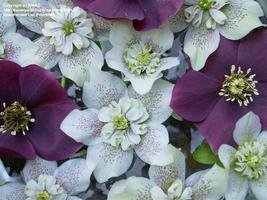 Lenten Rose - Helleborus orientalis (Photo courtesy of KMAC)
Lenten Rose - Helleborus orientalis (Photo courtesy of KMAC)
So if I lost you with all that botanical jargon, come back to me. All you really need is the genus, species and sometimes cultivar name to search about a plant.
The Big Three: Genus, Species, and Cultivar
The last three classifiers of botanical taxonomy are genus, species and cultivar. These are the most important and arguably all you need in any plant search, classification, or reference. Even if each individual generic (genus) or specific epithet (species name) is confusing and hard to pronounce, their function is not.
Most often, people that have knowledge of botanical Latin do not know the background or historical context of the nomenclature; they have simply memorized Latin names in order to be more precise in referencing. Seven out of ten times, a person that uses botanical Latin is not trying to show off, that is just how they refer to plants by rule. If you are completely out of the loop on this method, truly it just takes a little understanding and you'll be on the same page in no time. DG's own Jill M. Nicholaus wrote a great article on why it is important to use botanical Latin if you need some convincing. (And if you are one of the remaining 30% who are curious about plant names, Botanary contains thousands of botanical terms, their meanings and pronunciation.)
How can you tell the difference?
This is easy once you know how to read botanical Latin. The only problem is that plant names are written in many different permutations, much like a woman could be referred to as Jane Doe, Mrs. Doe, Mrs. John Doe, Ms. Jane Doe, etc. However, because you know how to identify a first name from a surname and a woman's name from a man's, you can classify any of those permutations in your head logically. Her first name is Jane and her last name is Doe. Botanical Latin is the exact same way; once you know how to logically categorize what you see, it is as easy as that.
Some good rules of thumb:
It is always, always, always the case that:
Echinacea purpurea ‘Magnus'
Genus species cultivar
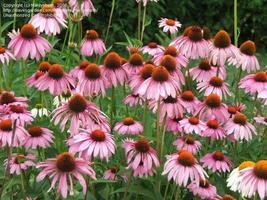 Purple Coneflower - Echinacea purpurea 'Magnus' (photo courtesy of Marilynbeth)
Purple Coneflower - Echinacea purpurea 'Magnus' (photo courtesy of Marilynbeth)
You will not see them in any other order, unless the author is mistaken. You will never see purpurea Echinacea ‘Magnus.' You should also never see the cultivar name in any other form than in single quotations.
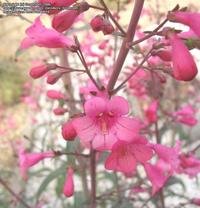 Parry's Penstemon - P. parryi (photo courtesy of Xenomorf)
Parry's Penstemon - P. parryi (photo courtesy of Xenomorf)
Differentiation
It is important to differentiate between a genus name and a common name before you search for a plant, much like tissue versus Kleenex. Obvious? What about these plants:
Brugmansia. If you search the PlantFiles by putting ‘Brugmansia' in the Common Name field, you will only fetch 4 results. We all know there are more brugs than that out there! However, if you type Brugmansia into the Genus field, you will net 388 results, because in fact Angel's Trumpet is the common name and Brugmansia, which is commonly used, is actually its genus classification. The same goes for often-referred-to-by-their-genus-names Artemisia, Buddleja, Viburnum, and Penstemon.
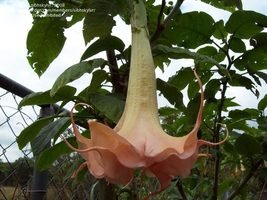 Brugmansia 'Adeline' (photo courtesy of sibhskylvr)
Brugmansia 'Adeline' (photo courtesy of sibhskylvr)
Hibiscus. On the other hand, some plants such as hibiscus are searchable both ways. Hibiscus is both the common name and the genus name and searching either fetches over 7,500 results. This is also true for cannas, irises and narcissus.
Carex. Some plants, like carex (sedge), are known equally well by their genus name and by their common name. However, if you run a search for the common name carex, nothing will result. You would either have to search sedge as the common name or Carex as the genus. This is the same case for Echinacea, the genus name for purple coneflower. You will not find any results if you search echinacea in the common name field, even though many people use that name to commonly refer to the plant.
Crepe Myrtle. Plants that are less confusing, like the crepe myrtle or Japanese maple, are easily differentiated between common name and genus name. Rarely will you hear someone say, "I saw the most beautiful Lagerstroemia while in Texas." For these plants you just have to be aware of which search box you are typing in.
How to use this information in a search
People often get needlessly frustrated when using the PlantFiles search feature. If you understand the basics of how to identify each part of a plant's name, you will be able to search successfully. Now that you know the difference between a genus, species and cultivar, you'll know which word to put in which search category. In all honesty, even people that have a vast understanding of botanical nomenclature can still mess up while searching for information.
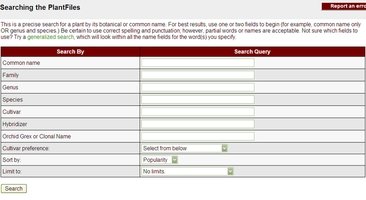
Make sure that when you are searching you put the genus name in the search box separate from the species name. If you type "Rosa rugosa" into the genus or species field of a search, you will find nothing. Separating "Rosa" from "rugosa" into the proper fields of genus and species, you will net 24 matches.
Similarly, if you put the genus name into the common name search box and your search comes back with nothing or not what you were looking for, try another search with it in the genus box to see what you find.
On a sidenote, when using correct botanical Latin names such as genus and species, the correct way to format it is by using italics as seen in this article. If you are referring to a common name it neither needs to be capitalized nor italicized even if the word can also be used as the genus name (i.e. brugmansia vs. Brugmansia). Do note though that in the search feature you don't not have to bother with italics or capitalizing, but your spelling is crucial.
If your searches are not fruitful in any variation, try using the more generalized search.
Pop Quiz for Understanding:
Label the classifications: genus, species, and cultivar
•1 1. Arisarum proboscideum
•2 2. Hakonechloa macra 'Aureola'
•3 3. Crinum powellii
•4 4. Tricyrtis
•5 5. Impatiens niamniamensis 'Queen Congo'
•6 6. I. pseudacorus
How did you do? Answers will be posted below. If you are becoming more familiar with the classifications, how they look, and how to use them, then you likely did very well on the quiz and you will likely be much more successful in your future searches. Please use the PlantFiles search features often because the more we know about our plants, the better care we can take of them.
Image of monkey courtesy of Morguefile user Seeka.
Citations:
•1. [ 1]. http://www.csupomona.edu/~larryblakely/whoname/who_pary.htm
Copyright © www.100flowers.win Botanic Garden All Rights Reserved